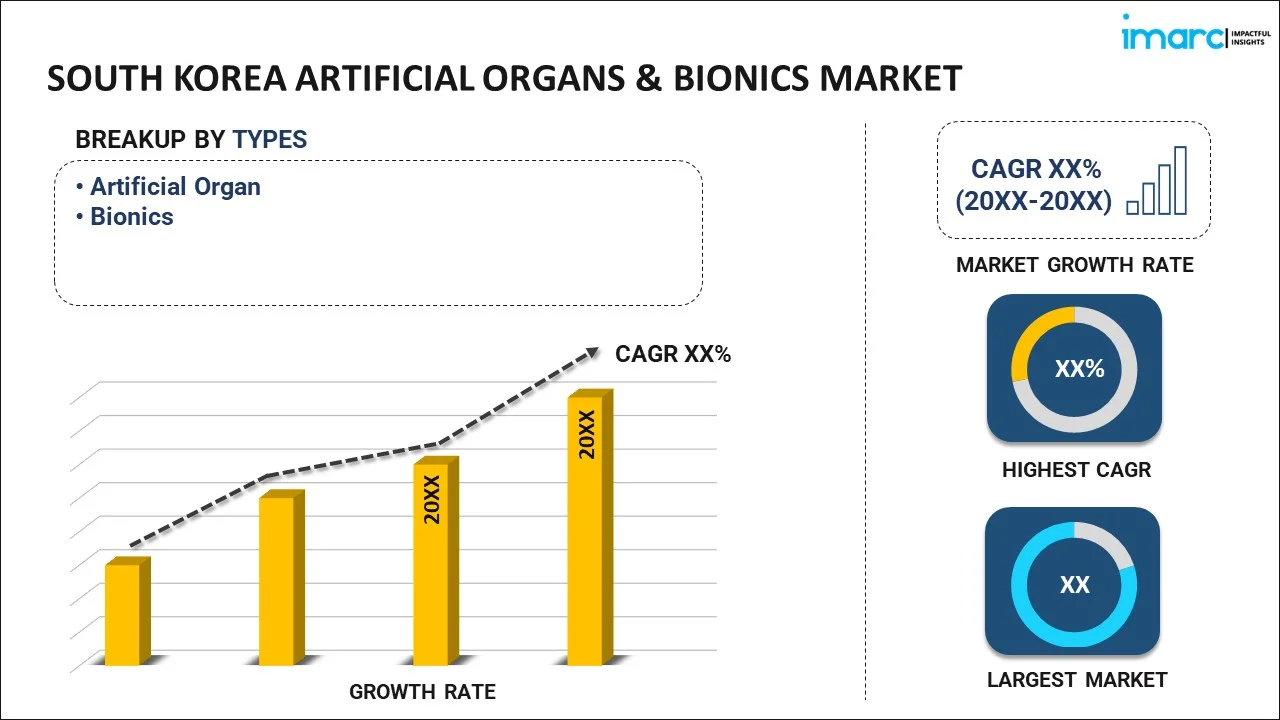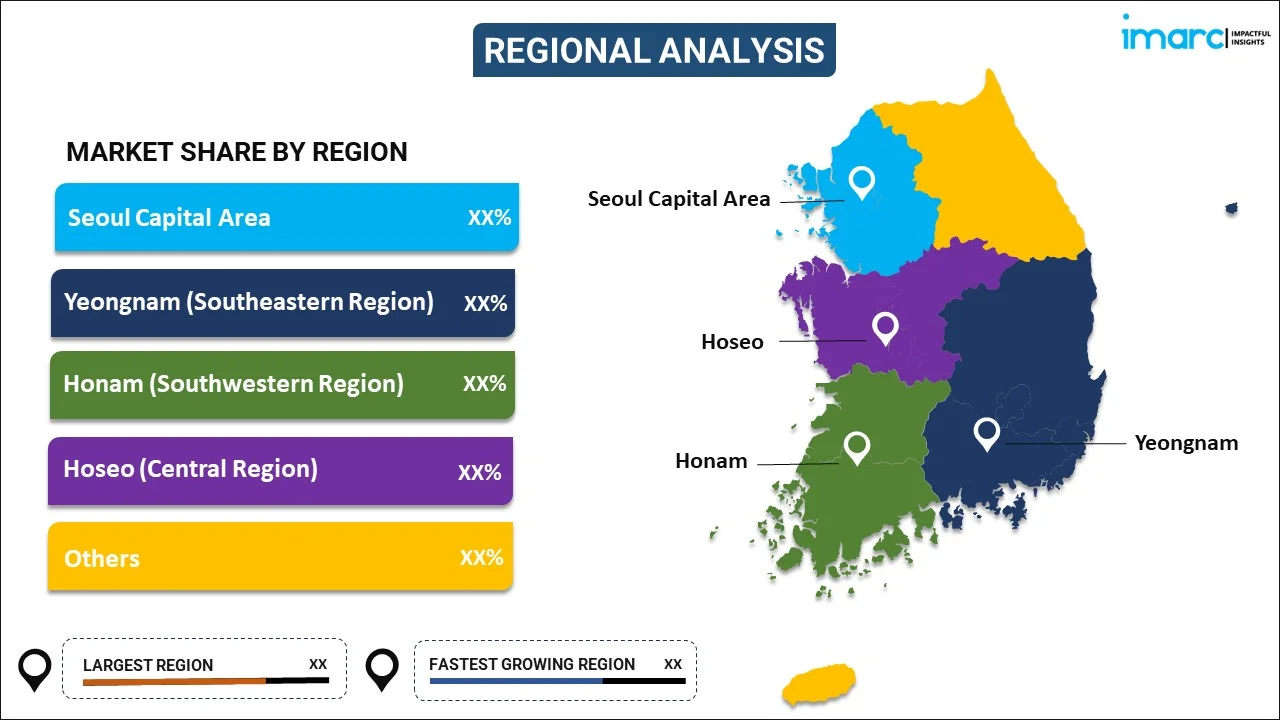
South Korea Artificial Organs & Bionics Market Report by Type (Artificial Organ, Bionics), and Region 2025-2033
Market Overview:
South Korea artificial organs & bionics market size reached USD 930 Million in 2024. Looking forward, IMARC Group expects the market to reach USD 1,400 Million by 2033, exhibiting a growth rate (CAGR) of 3.9% during 2025-2033. The rising chronic population, significant technological advancements, favorable government support, expanding medical tourism, increasing patient awareness and acceptance, collaborations and partnerships, and growing healthcare infrastructure represent some of the key factors driving the market.
|
Report Attribute
|
Key Statistics
|
|---|---|
|
Base Year
|
2024 |
|
Forecast Years
|
2025-2033
|
|
Historical Years
|
2019-2024
|
| Market Size in 2024 | USD 930 Million |
| Market Forecast in 2033 | USD 1,400 Million |
| Market Growth Rate (2025-2033) | 3.9% |
Artificial organs and bionics represent groundbreaking innovations in the field of medical technology. Artificial organs are engineered substitutes for natural organs, designed to replicate their functions in the human body. These remarkable devices can replace or augment vital organs, such as the heart, lungs, kidneys, or liver, offering hope and improved quality of life to patients facing organ failure or damage. They are typically constructed from biocompatible materials and are tailored to closely mimic the physiological processes of their natural counterparts. On the other hand, bionics, short for "biological electronics," is an interdisciplinary field that blends biology and engineering. Bionics involves creating electronic systems that interface seamlessly with the human body, often by integrating with natural biological processes. This can include the development of bionic limbs, which enable individuals with limb loss to regain mobility, or neural interfaces that connect the brain to external devices. Bionics has the potential to revolutionize healthcare by restoring function and enhancing the lives of individuals with disabilities.
South Korea Artificial Organs & Bionics Market Trends:
With the aging population in South Korea, the demand for medical interventions, such as artificial organs and bionics, increases. These technologies offer solutions for age-related health issues, including organ failure and mobility challenges. Additionally, the prevalence of chronic diseases, such as diabetes, cardiovascular diseases, and kidney disorders, is on the rise in South Korea. Artificial organs, such as artificial hearts and kidney assist devices, are in high demand to address these health concerns effectively. Other than this, South Korea has become a hub for medical tourism, attracting patients from around the world for various medical procedures, including organ transplants and bionics. This influx of international patients contributes to market growth. Besides this, increasing patient awareness and acceptance of artificial organs and bionics as viable treatment options have led to higher demand. Patients are more willing to explore these innovative solutions to improve their quality of life. In line with this, South Korea boasts a robust healthcare infrastructure, which includes well-equipped hospitals and clinics. This infrastructure supports the adoption and integration of artificial organs and bionics into the healthcare system. Furthermore, South Korean manufacturers are actively exploring opportunities in the global market, exporting their artificial organs and bionics to countries with similar healthcare needs. This international expansion contributes to the growth of the sector. Moreover, South Korea is known for its cutting-edge technology and innovation. The strong research and development infrastructure of the nation have enabled the creation of advanced artificial organs and bionics, making them more accessible and effective. Moreover, the government of South Korea has undertaken initiatives, including research grants, tax incentives, and policies, that support the development and adoption of these technologies in the healthcare and medical technology sectors.
South Korea Artificial Organs & Bionics Market Segmentation:
IMARC Group provides an analysis of the key trends in each segment of the market, along with forecasts at the country level for 2025-2033. Our report has categorized the market based on type.
Type Insights:

- Artificial Organ
- Artificial Heart
- Artificial Kidney
- Cochlear Implants
- Others
- Bionics
- Ear Bionics
- Orthopedic Bionic
- Cardiac Bionics
- Others
The report has provided a detailed breakup and analysis of the market based on the type. This includes artificial organ (artificial heart, artificial kidney, cochlear implants, and others) and bionics (ear bionics, orthopedic bionic, cardiac bionics, and others).
Regional Insights:

- Seoul Capital Area
- Yeongnam (Southeastern Region)
- Honam (Southwestern Region)
- Hoseo (Central Region)
- Others
The report has also provided a comprehensive analysis of all the major regional markets, which include Seoul Capital Area, Yeongnam (Southeastern Region), Honam (Southwestern Region), Hoseo (Central Region), and others.
Competitive Landscape:
The market research report has also provided a comprehensive analysis of the competitive landscape in the market. Competitive analysis such as market structure, key player positioning, top winning strategies, competitive dashboard, and company evaluation quadrant has been covered in the report. Also, detailed profiles of all major companies have been provided.
South Korea Artificial Organs & Bionics Market Report Coverage:
| Report Features | Details |
|---|---|
| Base Year of the Analysis | 2024 |
| Historical Period | 2019-2024 |
| Forecast Period | 2025-2033 |
| Units | Million USD |
| Scope of the Report | Exploration of Historical and Forecast Trends, Industry Catalysts and Challenges, Segment-Wise Historical and Predictive Market Assessment:
|
| Types Covered |
|
| Regions Covered | Seoul Capital Area, Yeongnam (Southeastern Region), Honam (Southwestern Region), Hoseo (Central Region), Others |
| Customization Scope | 10% Free Customization |
| Post-Sale Analyst Support | 10-12 Weeks |
| Delivery Format | PDF and Excel through Email (We can also provide the editable version of the report in PPT/Word format on special request) |
Key Questions Answered in This Report:
- How has the South Korea artificial organs & bionics market performed so far and how will it perform in the coming years?
- What has been the impact of COVID-19 on the South Korea artificial organs & bionics market?
- What is the breakup of the South Korea artificial organs & bionics market on the basis of type?
- What are the various stages in the value chain of the South Korea artificial organs & bionics market?
- What are the key driving factors and challenges in the South Korea artificial organs & bionics?
- What is the structure of the South Korea artificial organs & bionics market and who are the key players?
- What is the degree of competition in the South Korea artificial organs & bionics market?
Key Benefits for Stakeholders:
- IMARC’s industry report offers a comprehensive quantitative analysis of various market segments, historical and current market trends, market forecasts, and dynamics of the South Korea artificial organs & bionics market from 2019-2033.
- The research report provides the latest information on the market drivers, challenges, and opportunities in the South Korea artificial organs & bionics market.
- Porter's five forces analysis assist stakeholders in assessing the impact of new entrants, competitive rivalry, supplier power, buyer power, and the threat of substitution. It helps stakeholders to analyze the level of competition within the South Korea artificial organs & bionics industry and its attractiveness.
- Competitive landscape allows stakeholders to understand their competitive environment and provides an insight into the current positions of key players in the market.
Need more help?
- Speak to our experienced analysts for insights on the current market scenarios.
- Include additional segments and countries to customize the report as per your requirement.
- Gain an unparalleled competitive advantage in your domain by understanding how to utilize the report and positively impacting your operations and revenue.
- For further assistance, please connect with our analysts.
 Request Customization
Request Customization
 Speak to an Analyst
Speak to an Analyst
 Request Brochure
Request Brochure
 Inquire Before Buying
Inquire Before Buying




.webp)




.webp)












